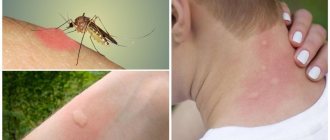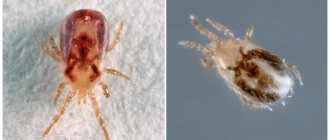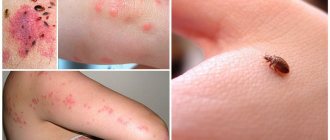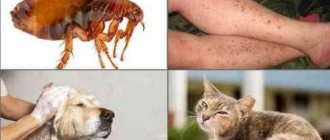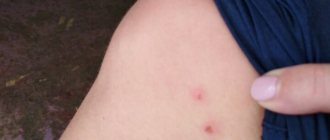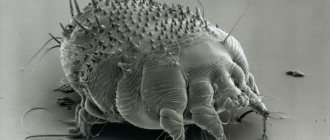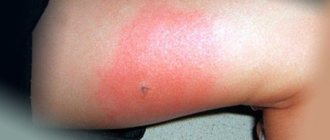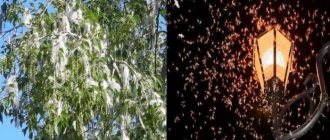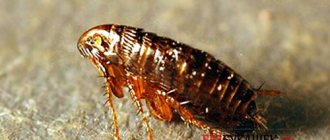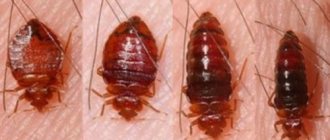How to determine if there are fleas at home. What do flea bites look like (photo)
To determine if there are fleas in the house. General characteristics of fleas:
- Color: reddish brown
- Size: 1 mm - 5 mm in length depending on the type
- Shape: oval
- Moves: by jumping
- Food: blood
- Do they carry diseases: yes
- Insects with complete metamorphosis
Fleas are very small in size, feed on blood, have no wings, and move by jumping. Insects usually live on 1-2 floors of apartment buildings or basements.
People can enter the premises with animals, on clothes from a walk, from neighbors, or from the basement.
What do flea bites look like?
Characteristics of a flea bite:
- look like a cluster of mosquito bites.
- look like a dot with a red (dark) center.
- bites are randomly placed on the body.
- The pimple from the bite turns red for about an hour.
- very severe itching
- In some cases, a flea bite may progress into an open wound.
Flea bite
This is what flea bites look like
How to find out if there are bed bugs at home.
Bedbugs are parasites of humans. They feed on blood. Unlike fleas, bedbugs usually bite at night, around 3-5 am. General characteristics of bedbugs:
- Reddish-brown color.
- 1 mm - 5 mm in length.
- Flat and adults look like an apple seed.
- Unlike fleas, bedbugs do not jump.
- Bed bugs move quite quickly up to 1 meter per minute.
- If you notice a flea and want to crush it, it will most likely jump away, but there is a chance of crushing a bug, although you also need to make an effort to catch it.
- Bedbugs, unlike fleas, do not jump or fly.
- Bedbugs feed at night; if there are a lot of bedbugs, they can bite during the day; there are also tropical bugs that bite around the clock.
- They get into the house in various ways: with things, from neighbors, you can see an article about this on the website
There are insects biting in the bed, do you want to know which ones?
Mosquitoes and midges can be detected with the naked eye. And they don’t sleep in bed with us either. Having made sure that these two types of “vampires” are not involved in the bitten skin, one should sin on other creatures. Below is a complete list of which arthropods bite you in bed. There aren't many of them. Look.
Bloodsucking
Fleas: It is a mistake to believe that the gastronomic preferences of this type of blood-sucking living creature are limited to cats and dogs. They enjoy feasting on people, especially preferring small children. Look at the distinctive features of bites:
- The attack site is mainly the legs. If you press down on a flea with your hand or stomach, it will happily bite you;
- Activity - attack at any time, including at night;
- Appearance - they come to the apartment with their pets. They can live in mattresses and sofas, because by nature they love warmth. They are able to live in rags, behind wallpaper, under floors.
The bites are characterized by an irregular shape and severe itching, much more powerful than that caused by mosquitoes. Small jumpers have a fairly strong shell, so they can only be crushed by squeezing them between the nails. They live from 1 to 18 months, due to which the population can increase significantly if extermination is not carried out in time.
Bedbugs: small (3-8 mm), and therefore not subject to mechanical stress. They drink blood using their trunk, making the tracks indistinguishable from mosquito marks. It is almost impossible to get rid of them using improvised means. “Vampires” operate exclusively at night, crawling out of furniture and even flower pots. One individual bites several times a night, and people’s faces also suffer.
Lice: we are talking about a type of linen that, for unknown reasons, has become increasingly common among us. Previously it was believed that the creature appears due to unsanitary conditions, but this theory has not been confirmed. Animals move on things - you could spend the night in a hotel and bring it home, or a friend brought “guests” with him. Unlike regular lice, these do not live on humans.
Other
Bedbug on the arm
Insects in bed bite us not only because they want to eat.
Some species are simply defending themselves. We are often asked to exterminate ants in the house. In addition to ruining food, they also run on your face. In fact, the problem lies in the availability of food near the sleeping area. Some people put sweet tea on their nightstand, others crunch treats on their favorite pillow, leaving crumbs behind. In this case, there is no need to be afraid of cockroaches, because they are quite cautious and prefer not to approach a person. Although, in the company’s practice, there were neglected cases when mustachioed animals fell on people from the ceiling, albeit without biting.
Features of bedbug bites
Some features of bedbug bites:
- Bed bug bites are flat and red.
- Bites often appear in tracks of 3 to 5 bites in a row.
- Bites take a long time to heal.
- Itching appears gradually.
- If an adult bites, it injects an anesthetic, so the insect is difficult to notice after the bite.
- If small bugs bite, the bite is felt immediately.
- They bite at night.
Details about bedbug bites
This is what bedbug bites look like
Bedbug bites
We understand the traces
So, how can you determine that your home is infested with bed bugs and not some other parasite? These pests can be identified by a number of signs that they invariably reveal themselves to be:
- Bedbugs are not the most voracious insects and can go without food for quite a long time. Even if there is always a person in the house, they will attack every 4-5 days. In some cases, the interval between bites can be more than a week. If the room is heavily infested, they will bite approximately once every 2-3 days. If you are bitten every night, other pests are probably to blame.
- If you've ever been bitten by bedbugs, then you know how many times they can bite. An adult drinks up to 7 ml of blood per night. But the insect cannot suck out such an amount of blood from one puncture, so it crawls away and pierces the skin in another place. Sometimes the punctures are unsuccessful - then the parasite tries again on another area of the skin. This feature of bedbug feeding leads to the fact that by the morning chains of 15-20 punctures appear on the skin, often with dried spots of blood. If there were a lot of insects, the chains may merge into large red spots. They cannot bite with single bites - if you find rare, lonely marks, then they were not left by bedbugs.
- Bedbugs almost never bite domestic animals - cats and dogs. This is mainly due to the thick fur and good sense of smell of animals, which makes it easy to smell an uninvited guest. If your pets suffer with you and constantly itch, then most likely they are not bed bloodsuckers.
- These insects rarely transmit dangerous diseases to people, but their anesthetic can cause allergic reactions in 80% of people. Allergies manifest themselves differently in everyone - from simple itching and rash to anaphylactic shock and fainting.
- Try to move out of the suspicious room for a while. If after a week the night attacks continue in another room, then perhaps your house is really infested with bed bugs - they easily find the victim by smell and can migrate to another room. Oddly enough, this behavior is not typical of all insects.
- Rooms infested with these insects give off a characteristic “bedbug” smell, which many associate with spices, cognac and nuts.
How can you decide who is biting a bug or a flea?
Visually inspect the place of the bite on the body; you can determine by 90% who bit you. If it seems that unknown insects are biting, pay attention to the following signs that may give away the “intruder”... Bedbugs
- traces of blood and feces on sleeping places
- discarded skins
- bite at night, on a sleeping place
- bedbugs do not bite immediately, but several days after they appear
- the bites begin to itch gradually
- flat shaped bites
- bedbugs do not carry diseases
- allergic reactions from bites
Fleas
- bite sites on legs
- bite when you sit on the carpet, floor
- pets have itching
- When fleas enter the house they immediately begin to bite
- after bites itching appears immediately
- swelling quickly appears at the site of the bite
- fleas are carriers of diseases
Lovers of human blood
The presence of blood-sucking parasites in an apartment not only gives its residents an unpleasant itchy sensation in the bitten areas, but can also cause sleep disturbances and even nervous disorders.
In addition to bed bugs, which are the most famous and widespread insects that love to feed on human blood, you can find other similar pests in nature that bite night and day.
Therefore, if someone wakes up in the morning and discovers that he has been bitten by invisible bugs, and he knows for sure that they cannot be in the apartment, then you can try to determine the type of “bloodsucker” by the appearance of the wound at the site of the bite. Below is a list of possible contenders, their descriptions and methods of struggle.
Who gets bitten in bed at night if it's not a bed bug bite? Other parasites can also feed on blood.
There are different types of fleas; they can appear in people's homes. Fleas are insects of insignificant size; they have the ability to move quickly thanks to their jumps. Therefore, it is difficult to catch her. Fleas bite in the middle of the night and day. Compared to other insects that bite people, fleas bite mainly during the day, but if the colony is large, they also bite during night sleep.
A feature that clearly indicates who bitten is pain when punctured. Fleas do not secrete an anesthetic secretion, so every puncture by the pest is noticeable, with an immediate reaction. The only point is that the flea secretes a certain enzyme that prevents the blood from clotting. Due to this, an allergy appears.
Swelling appears in the bitten area. A flea can bite any part of the body, causing swelling. As the area becomes swollen, redness becomes visible and sometimes begins to swell with a purulent crust. The bitten areas after parasites are of a chaotic order, compared to a bug bite.
fleas in bed
The redness that appears after the puncture indicates that the pest has suffered a serious illness, helminth eggs.
Besides fleas, the only thing that bites a person is a lice. It is easy to identify, because such parasites live in certain areas of the scalp, pubis, and armpits. Traces from lice punctures are recorded in the areas where they are located. When a lice bites, no pain is felt, especially if the number of pests is small. With numerous punctures, the areas become very itchy, and then infection gets there if you do not fight these parasites.
They multiply instantly, getting on the bed linen, eggs are immediately laid, which are impossible to see. When pests bite, they leave certain marks where the blood vessels are located.
The problem with lice must be solved immediately, since they are able to exist without food and go to the waiting stage.
Pubic lice are observed in those who have promiscuous sexual relations. Parasites live in the groin, where they gnaw and cause discomfort in humans.
lice in bed
Clothes insects live on clothes. When putting on pants, the louse gnaws at any part of the body.
Mosquitoes
These individuals are the most harmless ones who bite in the middle of the night. Their presence can be heard through an annoying squeak. They get along well on the street and in houses. And if it is possible to hide from other blood-sucking creatures by leaving the room, then it is impossible to escape from a mosquito. Mosquitoes live for 1-2 days, leaving a considerable number of punctures. They have a clear tendency to attack - they begin to bite when dusk comes, and when it is deep into the night, they calm down.
It is worth considering that mosquitoes bite everywhere, regardless of where a person is, when compared with blood-sucking mosquitoes, which are bed pests. Also, there are no mosquitoes at home in winter, so if you don’t know who bit you at night in winter, it’s definitely not him.
mosquito bite
Cockroaches
Oddly enough, Prussians are also capable of biting in the middle of the night. Situations have been recorded where cockroaches bit babies' eyelashes, skin around the lips, and nails. A Prussian dog may start biting if there are no food resources or moisture.
How to tell if a tick is biting you.
Mites are another pest that may end up in your home. Ticks are carriers of dangerous diseases.
Ticks belong to the class of arachnids. Ticks, like bedbugs, are parasites; they feed on the blood of birds and mammals.
There are three main families of ticks: Ixodid ticks, Argas ticks and Nuttalliellidae.
There are more than 700 species of ixodid ticks.
There are about 200 species of argasid mites. These ticks generally prefer to feed on bird blood rather than human blood.
Nuttalliellidae ticks have only one species, found in southern Africa.
Bedbugs and ticks both feed on blood, but that's where their similarities end.
Bed bugs are smaller in size, and ticks are larger in size. The red bite has a rounded spot on the surface of the skin, the shape is rarely oval or with jagged edges
Who can bite in bed at night?
When figuring out who might bite in bed at night, the easiest way would be to catch the bloodsucker right at the crime scene, take a good look at it and compare it with photos on the Internet.
And after that, take the necessary countermeasures. If someone bites you in bed at night, then this article is for you! Of all the insects, bedbugs are, of course, the leader in creating a feeling of discomfort. However, there are other bloodsuckers besides bed bugs that can bite a person in bed at night.
The constant presence of blood-sucking parasites in the bed is not just sleep disturbances, nightmares at night, and itchy bites in the morning, but also the risk of contracting quite dangerous infections. Yes, such that the next day you can be busy all day just getting rid of bites. For example, some blood-sucking insects are potentially capable of transmitting pathogens of encephalitis (and we’re not just talking about ticks), plague, anthrax, and typhoid. Only this is enough so that at the first suspicion of the presence of such insects in the house, immediately take measures to remove them.
You shouldn’t expect that living in a big city and a comfortable apartment will completely protect you from insects in your bed. A very characteristic feature of these human parasites is their indifference to the sanitary condition and cleanliness of the room, because they feed on blood, and not on the remains of our food. After reading this article you will know who can bite in bed at night.
